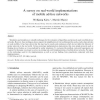Free Online Productivity Tools
i2Speak
i2Symbol
i2OCR
iTex2Img
iWeb2Print
iWeb2Shot
i2Type
iPdf2Split
iPdf2Merge
i2Bopomofo
i2Arabic
i2Style
i2Image
i2PDF
iLatex2Rtf
Sci2ools
ADHOC
2007
2007
A survey on real-world implementations of mobile ad-hoc networks
Simulation and emulation are valuable techniques for the evaluation of algorithms and protocols used in mobile ad-hoc networks. However, these techniques always require the simplification of real-world properties such as radio characteristics or node mobility. It has been shown that this may lead to results and conclusions which do not reflect the behavior of ad-hoc networks in the real world. Various prototype implementations demonstrate that even simple protocols such as flooding do not behave as it was predicted by earlier simulation. To overcome this problem, real-world experiments are required. In this paper, we present a survey on existing real-world implementations of mobile ad-hoc networks. We report on the technology used for the implementations as well as on key findings from experiments conducted with these implementations. Ó 2005 Elsevier B.V. All rights reserved.
| Added | 08 Dec 2010 |
| Updated | 08 Dec 2010 |
| Type | Journal |
| Year | 2007 |
| Where | ADHOC |
| Authors | Wolfgang Kieß, Martin Mauve |
Comments (0)

